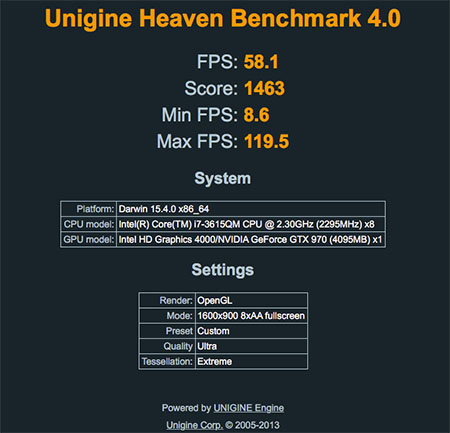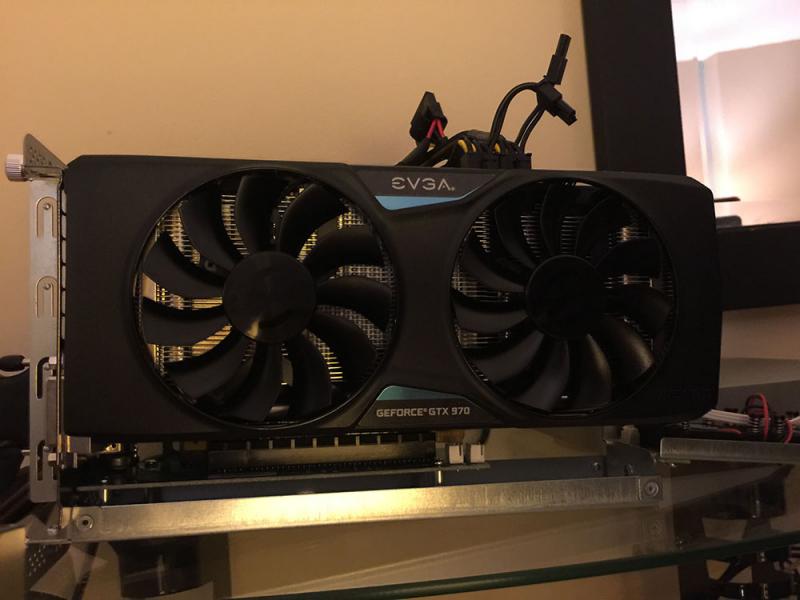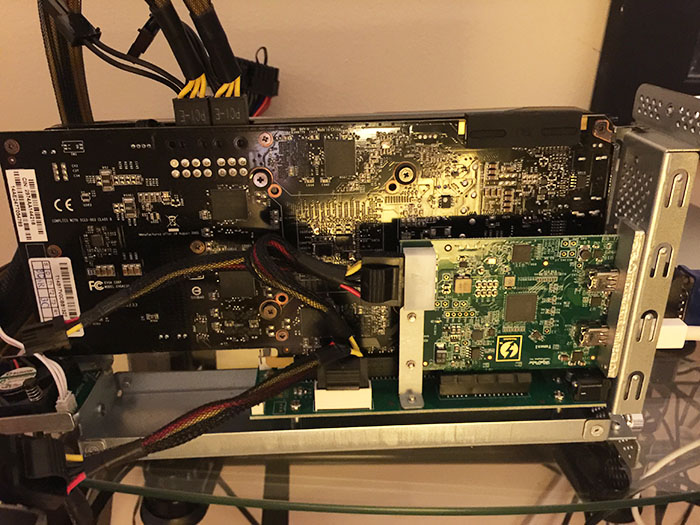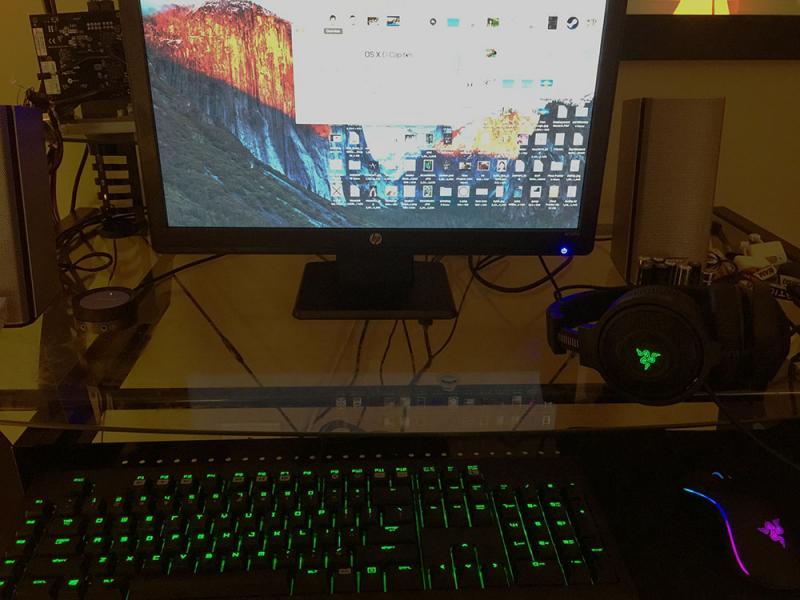Search the Community
Showing results for tags 'diy egpu'.
-
Hello all, I recently put together my egpu configuration using the video below down to a T. Every part of my set up is in this video and I've done exactly like this guy has said to make my set up. I've gotten my egpu to work finally by plugging in the thunderbolt2 cord when both the MacBook and egpu are powered down. Then I power on my back into the selection screen to choose windows or mac. Then I turn on my egpu and hope for the best. I've found this works about 30-40% of the time so if someone has a way to increase my chances feel free to comment. I'm using a MacbookPro 13in Retina with dual core processor and Intel Iris 6100 (Late 2015 MacBookPro 13in retina). Anyways once I am booted into windows (I'm using windows to use the egpu on the internal screen because this was meant as more of a mobile device) and I've checked the device manager to make sure the gtx960 is working properly (sometimes I get "no drivers are installed for this device and I have to reboot and try again) I try and run a game. I use WoW as a test for my graphics card. I have msi afterburner installed and I play WoW off an external HDD since I have the 128gb version of the MacBook pro. The graphics card fan never starts to spin. I monitor afterburner and at 50degrees celsius it still hasn't kicked on. I've only upped the graphics on WoW to about half 5/10 and after a few minutes of being on that setting the game crashes and I get a blue screen telling me there was a problem with windows. I'm at a loss and really upset since I've payed 400-500$ for this and it's not working and has given me a lot of trouble. There has to be someone out there who has this set up and dealt with this issue. I can't be the only one. I think the graphics card tends to crash around 60 degrees celsius and even using msi afterburner I've tried to increase the fan speed but even at 100% the fan just tilts a little bit when I look at it and never takes off. When the system first turns on though the fan seems to spin at 100% but after about 20 seconds the fan stops even though the graphics card is detected. So if anyone has dealt with this issue or knows how to overcome it please let me know. I shouldn't have to buy anything else to make this work since the guy in this video seems to have his set up working just fine. Thanks in advance everybody. Ps. Please help!
-
Hello fellas. This is my 3rd eGPU setup. I had an Akitio and Sonnet III-D setup before. By far, I think this is the easiest setup I had compared to the previous two. Maybe because I am not just too adventurous of adding extra effort with creating or dealing with molex-barrel plug and riser. That is just me. Again, it will be to someone's preference towards their eGPU setup. Got a last pair from a certain seller of this Rocketstor TB2 at Amazon for 218$ two weeks ago. Current price right now is around $234 +/- The setup is pretty straight forward similar to @Scooter's setup. I removed the 2 molex cables from the two board and replace it with the molex cables from the PSU. I bent the fan section of Rocketstor to accommodate the length of my GTX 970. For the reason that I don't have to remove the board from the case. I'll look for some small and clean enclosure in the future to house my setup. The Hardware Mac Mini Late 2012 on OSX El Capitan 10.11.4 GTX 970 SC 4GB Highpoint Rocketstor 6361A Corsair CX500 (80) Paper clip method Shitty monitor for now After putting the hardware together, I just have to run @goalque's automated eGPU script and everything went smoothly!
-
Hi guys, Following on from @squinks' work: http://forum.techinferno.com/implementation-guides/6689-%5Bguide%5D-2013-15-macbook-pro-gt750m-gtx780ti%4016gbps-tb2-sonnet-ee-iii-d-win8-1-a.html#post91182 I have finally got my Sonnet Echo Express SE II working with the MSI Nvidia GTX760 and my late-2013 Macbook Pro 15" which I custom ordered to have only the Intel Iris 5200 GPU. It is also a quad-core with 16GB ram and 512GB SSD. I am powering the card using a Corsair RM650 because that is what was easily available, fully modular (so I only need the PCIe power cable) and has a power switch easily accessible. I am running Windows 8.1 which I have installed UEFI using this guide. Originally when I received the Sonnet I found out that the PCI slots were only 8x length and so you could not insert the graphics card which is 16x length. Because I am a bit of an idiot and couldn't find a google answer easily enough I tried to hack off the end of the slot with a utility knife. Unfortunately it seems that when I did that I put too much pressure on the PCB and broke it. I received the new board yesterday and you can see in the photo below that it looks like in the later revision (right) they changed the left slot from an 8x to a 16x so you don't have to hack up the slot like I (failed) to do. It is a shame that they didn't extend both of the slots as there would be more airflow if the middle slot was 16x too as the edge of the enclosure would be further apart. Also, the power cables only just fit and are under some pressure when the case is on, I haven't been able to find many 90 degree 'low-profile' PCIe power cables but that would solve this problem. In terms of operation it is a bit of a pain. If the Sonnet and the graphics card are powered when you turn on the machine then Apple's BIOS disables the Intel GPU. This will work perfectly with an external screen but if you have used one of these MacBooks you will know how incredibly good the MacBook's screen is. To get Optimus (or to install drivers) my turnon sequence is: 1. Turn on machine with only the Sonnet plugged in (PSU off). It annoyingly doesn't have a power switch but will turn on when the Thunderbolt cable is plugged in and MacBook is powered on. Hold down the alt/option key so you can select Windows. 2. As soon as the Apple startup chime is heard turn on the PSU (and therefore the graphics card). 3. Quickly start up Windows. I suspect something is happening with the Sonnet's power settings that if you delay then the GPU is not detected. Weird. 4. You should be able to tell the GPU has started as Windows does some strange stuttering on startup only (e.g. typing in password is strangely laggy) but this is completely gone after logging in. I haven't got that many benchmarks but you can see it is running correctly over Thunderbolt 2.0: CUDA-Z Performance Information ----------------------- Memory Copy Host Pinned to Device: 1262.49 MiB/s Host Pageable to Device: 1128.11 MiB/s Device to Host Pinned: 1352.1 MiB/s Device to Host Pageable: 1206.5 MiB/s Device to Device: 64.3746 GiB/s If you do the maths then Host to Device (1262)+Device to Host (1352) then we are getting pretty good speeds: 2614 (Megabyte / s) = 20.421875 Gigabit / s Also, you can see this is much higher than the Thunderbolt 1 Thundertek CUDA-Z score (for Device to Host only) of 790MiB/s vs 1352.1 MiB/s (171%). Now if only we had some other manufacturers interested they could quickly address these BIOS/EFI level issues and we could have true plug-and-play eGPUS!
- 26 replies
-
- 6
-

-
- apple egpu
- diy egpu
- (and 7 more)












